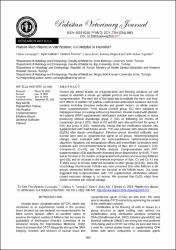Platelet-Rich Plasma in Vitrification; is it Helpful or Harmful?

Göster/
Tarih
2023Yazar
Çavuşoǧlu, TürkerGökhan, Aylin
Tomruk, Canberk
Şirin, Cansın
Kılıç, Kubilay Doǧan
Yiǧittürk, Gürkan
Üst veri
Tüm öğe kaydını gösterKünye
Çavuşoğlu T, Gökhan A, Tomruk C, Şirin C, Kılıç KD, Yiğittürk G, 2023. Platelet-rich plasma in vitrification; is it helpful or harmful?. Pak Vet J, 43(3): 500-506. http://dx.doi.org/10.29261/pakvetj/2023.077Özet
Human and animal studies on cryoprotectants and freezing solutions are still needed to establish a simple yet reliable protocol and increase the success of cryopreservation. The main aim of this study was to evaluate the short- and longterm effects of platelet-rich plasma, a well-known antioxidant substance due to its contents including bioactive molecules and growth factors, on whole ovarian tissue cryopreservation. Fresh tissues (control group, G1) were subjected to histological tissue processing without any treatment. Ovaries treated with plateletrich plasma (PRP)-supplemented vitrification solution were subjected to tissue processing without cryostorage group 2 (G2) or following six months of cryostorage group 3 (G3). Steps in G2 and G3 were also performed for group 4 (G4) and group 5 (G5), respectively, except that the vitrification solution was supplemented with fetal bovine serum. PRP was activated with calcium chloride (CaCl2) after double centrifugation. Ethylene glycol, dimethyl sulfoxide, and sucrose were used as cryoprotective agents in all groups. Histomorphological changes were evaluated with the semi-quantitative histochemical-scoring algorithm. Apoptotic and antiapoptotic effects and intercellular connections were evaluated with immunohistochemical staining of Bax, Bcl-2, Caspase-3 (C3), Connexin-43 (Cx-43), and TUNEL analysis. Cryopreservation with PRPsupplementation (G3) significantly increased tissue degeneration (p<0.05). There was an increase in the number of degenerated both primary and secondary follicles (p<0.05), and an increase in the immune expression of Bax, C3 and Cx-43 and TUNEL assay in G3 was observed compared to other groups

















